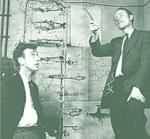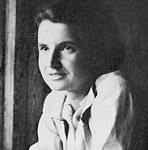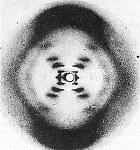|
SCIENCE IN THE NEWS - Genetic Engineering VOICE ONE: I'm Steve Ember. VOICE TWO: And I'm Phoebe Zimmerman with the VOA Special English program Science in the News. This week, we look back at a major discovery in genetics. And we examine some of the issues created by genetic engineering. (THEME) VOICE ONE: February twenty-eighth marked an important anniversary. On that day fifty years ago, American scientist James Watson and British scientist Francis Crick told people about a discovery. The two young scientists had found the structure of deoxyribonucleic acid -- better known as D-N-A.
Every cell in every living thing contains D-N-A. This self-reproducing molecule carries the information to make living things from one generation to the next. VOICE TWO: James Watson and Francis Crick worked at Cambridge University in England. They found that each molecule of D-N-A is in the shape of a double helix. Imagine climbing the steps of a ladder. But this ladder does not go straight up. Instead, it turns to the right, around and around itself. That is what a double helix looks like. D-N-A is made up of genes. Researchers tell us that our bodies have about thirty-thousand genes. Think of these as sets of building plans. Genes are carried on lengths of D-N-A called chromosomes. Almost every human cell has forty-six chromosomes. Half come from our mothers, half from our fathers. (MUSIC) VOICE ONE: The chemicals that make up D-N-A are nucleic acids. There are just four kinds: adenine, thymine, guanine and cytosine. These nucleic acids -- represented by the letters A, T, G and C -- are called bases. Scientists say human chromosomes have about three-thousand-million pairs of these bases.
Each step of the double helix is a base made up of two kinds of nucleic acid. How these bases are organized along the ladder provides the information stored in genes. This information directs the making of proteins, the materials that build cells. (MUSIC BRIDGE) VOICE TWO: There was great competition to find the secret of life. This was before scientists had today's computers. Francis Crick and James Watson made mistakes. But in April nineteen-fifty-three Nature magazine published a one-page letter in which they described the structure of D-N-A. At first, the world did not react. Several years later, scientists proved that D-N-A can copy itself. In nineteen-sixty-two, James Watson and Francis Crick won the Nobel Prize for Medicine. They shared it with Maurice Wilkins, a British scientist who also studied D-N-A. VOICE ONE: Today, James Watson and Francis Crick are investigating new areas of science. Mister Crick works at the Salk Institute for Biological Studies in La Jolla, California. He now explores the biology of people’s brains. In fact, he and another researcher published a study on this subject in February in Nature Neuroscience magazine. Mister Watson has been president of Cold Spring Harbor Laboratory in Long Island, New York, for twenty-five years. During the nineteen-nineties, he also served as the first chief of the Human Genome Project. VOICE TWO: In two-thousand, President Bill Clinton and British Prime Minister Tony Blair announced the completion of this project. The human genome map describes a person’s full genetic structure. This map will help scientists to study the mysteries of health and to fight disease. Understanding the D-N-A molecule has opened up new areas of research. As Francis Crick and James Watson say, the possibilities are endless. (MUSIC) VOICE ONE Looking back, both scientists agree they never would have made their discovery without luck and help. One person whose work they used was a British chemist. Her name was Rosalind Franklin.
Rosalind Franklin had investigated the shape of D-N-A molecules. She hit them with X-rays. As she recorded images, one of them showed a molecule in the shape of an X. It provided strong evidence of the structure of D-N-A as a double helix. VOICE TWO Maurice Wilkins worked with Rosalind Franklin, but they were not friends. He did not tell her that he showed the picture -- known as Photograph Fifty-One -- to James Watson. Mister Watson and Mister Crick said nothing about this picture in their famous paper.
Some say that, because she was a woman, Rosalind Franklin never got as much recognition as she should have for her research. She might have shared the Nobel Prize with Watson, Crick and Wilkins. But Nobels only go to living people. Rosalind Franklin died of cancer of the ovaries in nineteen-fifty-eight, at the age of thirty-seven. (MUSIC) VOICE ONE:
Many of the possibilities for D-N-A research involve genetic engineering, including the creation of clones -- genetic copies of organisms. The birth of Dolly the sheep in nineteen-ninety-six caused excitement. But some see her death recently as a warning of the risks of cloning. Others, though, say cloning may help scientists improve animal productivity and find cures for human diseases. VOICE TWO: Animal doctors ended Dolly's life on February fourteenth at the Roslin Institute in Scotland. She suffered from progressive lung disease. She was six-and-a-half years old. Some sheep live to be eleven and twelve years old. Dolly’s main creator, Ian Wilmut, said the lung disease was not connected with her being a clone. Doctors said other sheep on the same farm also developed the same disease. Dolly was not only the largest mammal ever cloned. She was also the first to be cloned from a cell taken from an adult animal. In other cases, researchers worked from undeveloped cells. (MUSIC) VOICE ONE: Dolly's birth followed years of research and hundreds of failed attempts. Many animals died during these experiments, including ones malformed at birth. Mister Wilmut and a Roslin Institute team performed the successful process. To create Dolly, they replaced the genetic material in a sheep egg with D-N-A taken from the udder of a six-year-old female sheep. In the laboratory, the scientists got the egg to divide and grow. No biological father was involved. The scientists presented Dolly to the world in nineteen-ninety-seven. They named her after Dolly Parton, the American country singer. VOICE TWO: Dolly the sheep lived inside most of the time for security reasons. But she became a mother the more traditional way. With the help of a Welsh ram, she gave birth to four lambs -- three of them at once. But in nineteen-ninety-nine, the scientists discovered that her cells looked like the cells of a older sheep. Last year Dolly developed arthritis in the joints of one of her legs, a common condition of aging. (MUSIC) VOICE ONE: Since the birth of Dolly, scientists have cloned other mammals including monkeys, pigs and goats. Some researchers began to talk openly about cloning humans. But other experts argued that there is too much risk. A number of countries banned human cloning. In Washington last week, a bill to make human cloning a serious crime passed the House of Representatives and went to the Senate. VOICE TWO: Many countries permit cloning of cells from human tissue for research. The hope is that this could lead to cures for diseases like Parkinson’s and Alzheimer’s. Doctors say cloning might also help them find cures for diabetes and cystic fibrosis. But in the United States, President Bush has restricted the use of cloned human embryos in research. Scientists may work only with a limited number of existing lines of cells. Many people who support the ban say it is wrong to create life just to destroy it. Other concerns include the risk of damage in cloned babies. VOICE ONE: In American industry, some companies produce cloned animals to sell, but as yet not with approval to sell for food. Scientists say cloned pigs might solve the shortage of human organs needed for transplant. Pigs and people are biologically similar. So pigs may provide kidneys, hearts and other organs. Cloning could also provide a simpler, cheaper way to reproduce farm animals. People may want to reproduce pets that have died. Clones could also help save endangered animals such as the African wild cat from disappearing. This was one of the hopes for cc, a housecat cloned in Texas. VOICE TWO: Scientific progress, however, often creates moral issues. Some religious groups have not taken a position on cloning. Others hope to influence the debate. The Roman Catholic Church, for example, opposes cloning, while other Christian groups are divided. (THEME) Science in the News was written by Jill Moss and Jerilyn Watson. It was produced by Mario Ritter. This is Steve Ember. VOICE TWO: And this is Phoebe Zimmerman. Join us again next week for more news about science in Special English on the Voice of America.
|
| Главная страница |
| Форум сайта |
| Гостевая книга |
| Наши рассылки |
| Написать письмо |
| Теория |
|---|
| Грамматика |
| Произношение |
| Методики изучения |
| Учебные пособия |
| Практика |
|---|
| Чтение |
| Написание |
| Упражнения |
| Идиоматика |
| Тестирование |
| Сленг |
| Программы |
| Помощь |
|---|
| Курсы |
| Репетиторы |
 James Watson, left, and Francis
Crick.
James Watson, left, and Francis
Crick.
 Detail from a photograph by
Vittorio Luzzati in the collection of the National
Portrait Gallery in London.
Detail from a photograph by
Vittorio Luzzati in the collection of the National
Portrait Gallery in London. The
picture taken by Rosalind Franklin.
The
picture taken by Rosalind Franklin.